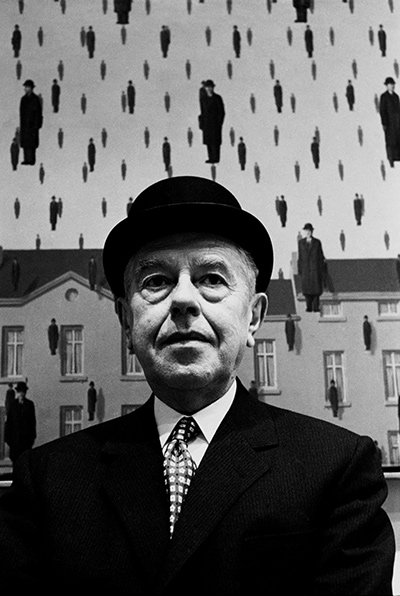Rene Magritte played a critical role in the rise of the Surrealist art movement during the 20th century
Magritte's artistic style was to suggest at the unseen, rather than the reproduction of reality as found in Realism. The Son of Man remains his most famous painting, perfectly capturing the surrealist and creative nature of his career. Magritte sat alongside the likes of Salvador Dali and Joan Miro in pushing forwards this new way of artistic thinking. Some of the developments made here also sprouted off into future art movements under the umbrella of contemporary arts.
Much of the earliest work from an experimental Magritte was based around Cubism which was a movement growing in popularity at the time, spearheaded by the work of Pablo Picasso and Georges Braque. There was also a spell later on in his career where his work resembled those of the impressionist movement of the mid-19th century. Bright landscapes brought a positivity back into his mind, which he had been lacking at that time. Magritte was known to be particularly familiar with the work of Van Gogh, Picasso and Paul Cezanne having spent some time producing copies of their original paintings in order to make ends meet during a period of financial struggle.
One element to Magritte's work was the reproduction of classic paintings but with a surrealist twist. Spoof artwork is now very common, but this was relatively new at the time. The Balcony by Edouard Manet received this treatment. The purpose of this was to encourage the viewer to see different elements within a painting that they are already familiar with. Many contemporary artists have also followed this route, such as Marcel Duchamp's version of Leonardo da Vinci's Mona Lisa.
Surrealism was to offer both a political framework as well as an artistic approach for many artists from the 1920s. There was very much a leftist agenda for many in this group, unhappy with the direction of mainstream society. The creative slant to surrealism allowed many different approaches to appear under this same umbrella of expression. Dali, for example, would represent his own dreams through art. Magritte was not as politically minded as some artists around this time, but still held a clear interest in and passion for improving the state of western civilisation towards a new, less selfish, status quo.
The artist's move to Paris as a young man followed a troubled period for his artistic career, with a solo exhibition having been roundly panned by critics. It was then that he would meet Andre Breton, a talented artist who also held great influence in his ideas for contemporary art. He was later to found the Surrealist art movement itself. There was then some work which was directly inspired by de Chirico, another notable surrealist. Some of this was erotic in nature, which was common for this art movement - see Dali's Young Virgin autosodimised by her own Chastity. This contrasted againgst the more abstract forms of Miro. See the paintings of Max Ernst too.
Hiding and concealing items in his work was used by Magritte to symbolise a feeling of alientation, rather than the literal meaning. This method was repeatedly used throughout his career. After an extended period in Paris, he would return to live in Brussels. It was now that he would develop his signature style, repeatedly using certain objects to convey his message. In the same way that Dali used melting clocks, Magritte used floating rocks as well as paintings within another painting. Human anatomy would also figure. Magritte would begin to bring sculpture into his work later on in life. The surrealist characteristics found in his paintings would continue into this medium, much as was achieved by both Picasso and Dali too.




